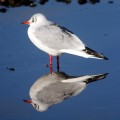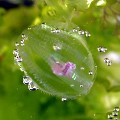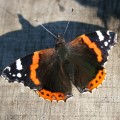Scottish Wildlife Watching in the Rhins, Scotland

Birds
With the Rhins being almost like an island with many different coastal habitats, it is no wonder that
bird life is in an abundance here. Soft sandy beaches provide feeding grounds for waders such
as oystercatchers, dunlins, redshanks, turnstones, ringed plovers
and golden plovers. Steep rocky cliffs provide breeding sites for guillemots,
razorbills, fulmars, gulls, cormorants and shags as well as peregrine falcons. Farm buildings provide homes for barn owls
and kestrels. Other raptors such as buzzards, hen harriers and, at night,
tawny owls, hunt over open farmland. You may also see sparrowhawks hunting common garden
birds. In woodlands and gardens it is always a pleasure to watch colourful and interesting inhabitants
such as crossbills, goldfinches, goldcrests, great-spotted woodpeckers, treecreepers
and siskins. Shingle banks are important nesting sites for terns.
Recent bird sightings in the area - particularly rarities can be found at the
Dumfries and Galloway Bird News or their Twitter account https://twitter.com/DGBirdNews.
Top Birdwatching Sites in the Rhins:
- The Mull of Galloway - A variety of seabirds nest on cliffs here in the summer, including kittiwakes, shags, comorants, razorbills, guillemots and black guillemots. You may also see rafts of puffin on the sea in summer. Gannets regularly fly by and you may see a passing shearwater. On top of the cliffs are peregrine falcons, twites and stonechats.
- Wig Bay/Loch Ryan - On Loch Ryan you will see various gulls, guillemots, razorbills, great-creasted grebes, red-breated mergansers, red-throated divers, shags, cormorants, gannets, wigeon and other ducks, whooper swans (in summer), mute swans and terns. The scar is exceptionally important for breeding terns.
- Corsewall Point - This is a great spot for watching passing seabirds, particularly the impressive gannets as the nose dive into the open sea, sometimes quite close to the shore. You may also spot storm petrels, sabines's gulls, shearwaters and skuas.
- Torrs Warren and Ringdoo Point - Okay, this is technically right on the edge of the Rhins but it is worth visiting for the woodland birds such as siskins and goldcrests, as well as waders, shelducks and swans on luce sands

Land Mammals
When most people think of Scottish wildlife they think of red squirrels and perhaps red deer and the Rhins is lucky enough to hold both of these species. Roe deer are also present and you may be lucky enough to spot fawns. Semi-wild goats are also present in places (see below). Brown hares are always great to watch here, but particularly in early summer when they box.
Top Mammal Watching Sites in the Rhins:
- Aldouran Glen - The woodland here is a fantastic place to spot roe deer.
- Corsewall Point - Look for hares here where they chase eachother round in circles. At the right time of year, you may catch them boxing - a sight not to be missed!
- Torrs Warren - This is actually the only place in the Rhins where I have come face to face with a red squirrel.
- Salt Pans Bay - Park at Galdenoch Castle and walk down to the bay and you should come across semi-wild goats and red deer.

Amphibians & Reptiles
There are few reptiles that are present in Scotland and the only reptile I've seen in the Rhins is the
common lizard (which, as the name suggests is quite common) though you may be lucky enough to see an
adder.
As for amphibians, there are plenty of toads, frogs and newts in the area.
Top Reptile & Amphibian Watching Sites in the Rhins:
- Aldouran Glen - this is one of the best sites to go looking for amphibians as the marshy area and ponds is ideal for frogs, toads and newts.
- Torrs Warren - go here in the summer to look for common lizards and perhaps adders too.

Sealife
One of the questions people often ask is 'where can I go whale and dolphin watching?' - as it happens
the Rhins is not a bad place for watching cetaceans from the shoreline or cliffside. The most commonly
seen cetacean is the harbour porpoise but bottlenose dolphins and even minke whales
have been reported.
Like Cornwall, we get the benefit of warmer currents from the gulf stream so basking
sharks and sunfish are sometimes seen.
Turtles have also been seen with leatherbacks being the most common, but stranded
loggerheads have been found in the area in the past.
What you are most likely to see out to sea from the Rhins is seals as both common seals and
grey seals are regularly seen, but unlikely to breed here.
On the seashore itself there are of fish like butterfish, wrasse, plaice, goby
and flounder. In rock pools you may find common starfish, sea gooseberries (pictured above)
sea slugs and sea hares, hermit crabs and much more.
Top Seashore Life Watching Sites in the Rhins:
- Dunskey Castle to Port Kale - This stretch of coatline is excellent for looking out to sea to find porpoises and other cetaceans, as there is a wide angle of vision.
- Corsewall Point - Good for spotting grey seals in particular
- Killantringan Bay - Rockpools galore with plenty of starfish, small fish and seagooseberries
- Port Logan - Look for flatfish like plaice and flounder here.
- Loch Ryan - Common seals can often be spotted in their classic 'banana' pose just off shore on outcroping rocks.

Minibeasts
I'm not going to attempt to go through all the different species of insects, spiders and other tiny critters seen in the Rhins but we do have a multitude of species that people like to watch, like butterflies, moths, damselflies and dragonflies.
Top Minibeast Watching Sites in the Rhins:
- Aldouran Glen - look for dragonflies and damselflies here in summer.
- Mull of Galloway - the wildflowers here attract butterflies like red admirals, common blue, grayling, peacock, whites and painted lady.
Can you help improve the information on this site? If you have any suggestions for things that you think should be included on this page, please let us know at webmaster@visitstranraerandtherhins.co.uk.
